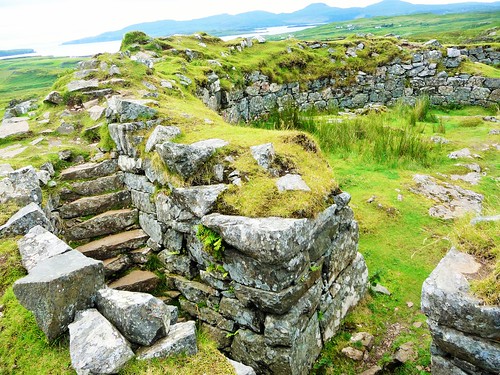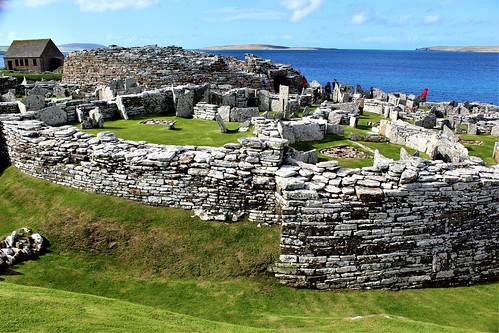Scottish Brochs
(Above
image is of Carloway Broch on Isle of Lewis, Outer Hebrides.)
Summary information
on Scottish brochs is provided below.
- Comprise tall, round towers which are not dissimilar to modern-day lighthouses.
- The walls were double-skinned and tapered. No mortar was used. The walls were bonded together at intervals by rows of flat slabs.
- Stairs were constructed between the double walls which provided access to galleries and small rooms on separate stories.
- Invariably located on prominent positions on the landscape. Likely high status homes for a local chieftain type person and his extended family and animals.
- At ground level access was by a small, narrow entrance which could be easily defended.
- There is evidence of some 500 brochs which are concentrated in the north, particularly the Northern Isles (Orkney and Shetland), Western Isles and Caithness on the mainland.
- Dated to the Iron Age, circa 200 BC to 200 AD after which they went out of use and the masonry was robbed for other buildings.
- Built by indigenous peoples (not Scots) from whom the Pictish culture later developed.
In this section can be found images
of three ruined brochs, one each from Isle of Lewis, Isle of Skye and Orkney.
An almost complete broch can be found on the uninhabited island of Mousa which
forms part of the Shetland Isles. The Mousa broch reaches a height of 42 feet.
Mousa Broch, Shetland
Double skinned walls with internal stairs at Carloway Broch, Isle of Lewis
Interior of Dun Beag Broch, Isle of Skye illustrating double- skinned walls with interior stairs.
Interior of Dun Beag Broch, Isle of Skye
Inside Broch of Gurness, Orkney
Broch of Gurness, Orkney.








I'm writing a family history and wish to use your photographs of the Mousa, the Dun Beag and the Broch of Gurness in the book. I plan to publish it privately for a few family members.
ReplyDeleteMay I please use your photographs giving your blog credit?
They are great.
Regards, Jim Munro Port Macquarie NSW Australia.
Jim, Sure, you can use the images strictly for purpose outlined. See also my blog post today on Mousa:http://www.nigelsphotoblog.co.uk/2019/05/mousa-shetland-scotland.html
DeleteIncidentally, I attended a Clan Munro reunion some years ago.
Regards
Nigel